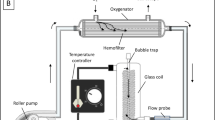Summary
The relationship between ischemic contracture and no-reflow phenomenon was studied in 59 isolated rat hearts during global ischemia. The contracture was measured by a water-filled balloon catheter placed in the left ventricular lumen. The time of the onset of contracture was changed by preischemic infusion with buffer containing 0.5 mmoles/l iodoacetate (IAA) in order to get early contracture, and by hypothermia which delayed the development of contracture. The first signs of contracture were noticed in normothermia (37°C) at 11 minutes, in hypothermia (26°C) at 25 minutes, and in the IAA-infused group at 3 minutes. The completion of contracture occurred in these groups at 25, 90 and 11 minutes, respectively. The myocardial perfusability was tested at the pre- and postcontracture state by infusing 0.1% fluorescein in isotonic saline into the cannulated aortic root. The myocardial area perfused with fluorescein was quantified in colour photographs taken under ultraviolet light of frozen whole-heart sections. The myocardial perfusion-expressed as percent of myocardial area-was 99% at the precontracture state in normothermia, 95% in hypothermia and 100% in the IAA-infused group. At the postcontracture state, the myocardial perfusion in these groups was 80, 56 and 18%, respectively. It was concluded that the no-reflow phenomenon in isolated rat heart is closely associated with the development of myocardial contracture during global ischemia.
Zusammenfassung
Bei 59 isolierten Rattenherzen wurde die Beziehung zwischen ischämischer Kontraktur und der Perfundierbarkeit des Koronarsystems in der postischämischen Phase untersucht. Die Kontraktur wurde mittels eines wassergefüllten Ballons im Lumen des linken Ventrikels gemessen. Die Zeit des Kontrakturbeginns wurde variiert durch präischämische Infusion mit einer Pufferlösung, die 0,5 mmol/l Jodacetat (IAA) enthielt, um das Einsetzen der Kontraktur zu beschleunigen, sowie durch Hypothermie, welche die Entwicklung der Kontraktur verzögerte. Die ersten Zeichen der Kontraktur wurden bei Normothermie (37°C) nach 11 Minuten, in Hypothermie (26°C) nach 25 Minuten, bei der Gruppe mit Jodacetat-Infusionen nach 3 Minuten verzeichnet. Vollständige Kontraktur trat bei diesen Gruppen nach 25, 90 bzw. 11 Minuten in Erscheinung. Die Perfundierbarkeit des Myokards wurde vor und nach der Kontraktur durch Infusion von 0,1% Fluorescein (in isotonischer Kochsalzlösung) in die Aortenwurzel geprüft. Der mit Fluorescein perfundierte Myokardbereich wurde durch Farbfotografien quantifiziert, die unter ultraviolettem Licht von gefrorenen Herzschnitten angefertigt worden waren. Die myokardiale Perfusion-ausgedrückt als Prozent der Myokardfläche-betrug vor Kontraktur in Normothermie 99%, in Hypothermie 95% und bei der Gruppe mit Jodacetat-Infusionen 100%. Nach Ischämie betrug die myokardiale Perfusion in diesen Gruppen 80, 56 bzw. 18%. Aus den Ergebnissen wird geschlossen, daß die gestörte Perfusion des isolierten Rattenherzens eng mit der Entwicklung einer Myokardkontraktur während der globalen Ischämie zusammenhängt.
Similar content being viewed by others
References
Alanen, K., T. J. Nevalainen, J. Lipasti: Ischaemic contracture and myocardial perfusion in isolated rat heart. Virchows Arch. Pathol. Anat.385, 143–149 (1980).
Armiger, L. C., J. B. Gavin: Changes in the microvasculature of ischemic and infarcted myocardium. Lab. Invest.33, 51–56 (1975).
Ashraf, M., L. Livingston, C. M. Bloor: Ultrastructural alterations in myocardial vessels after coronary artery occlusion. Scan. Electron Microsc.2, 501–506 (1977).
Baghirzade, M. F., U. Kirsch, U. Hauschild: Capillareinengung bei anoxisch und ischämisch bedingtem Anstieg des Coronarwiderstandes im Meerschweinchenherzen. Virchows Arch. Pathol. Anat.351, 193–204 (1970).
Camilleri, J. P., D. Joseph, J. N. Fabiani, A. Deloche, M. Schlumberger, J. Relland, A. Carpentier: Microcirculatory changes following early reperfusion in experimental myocardial infarction. Virchows Arch. Pathol. Anat.369, 315–333 (1976).
Downey, J. M., H. F. Downey, S. Kirk: Effects of myocardial strains on coronary blood flow. Circulat. Res.34, 286–292 (1973).
Fabiani, J. N.: The no-reflow phenomenon following early reperfusion of myocardial infarction and its prevention by various drugs. Heart Bull.7, 134–142 (1976).
Gavin, J. B., T. J. Nevalainen, R. N. Seelye, V. Webster, R. W. Thomson: An association between the onset of rigor and loss of vascular competence in early myocardial infarct. Pathology10, 219–225 (1978).
Hauschild, U., M. F. Baghirzade, U. Kirsch: Capillarkompression als Ischämiefolge. Elektronenoptische Untersuchungen an Papillarmuskeln des Menschen und des Meerschweinchens. Virchows Arch. Pathol. Anat.351, 205–224 (1970).
Hearse, D. J., P. B. Garlick, S. M. Humphrey: Ischemic contracture of the myocardium: Mechanisms and prevention. Amer. J. Cardiol.39, 986–993 (1977).
Humphrey, S. M., J. B. Gavin, P. B. Herdson: The relationship of ischemic contracture to vascular reperfusion in the isolated rat heart. J. Mol. Cell. Cardiol.12, 1397–1406 (1980).
Katz, A. M., M. Tada: The “stone heart”: A challenge to the biochemist. Amer. J. Cardiol.29, 578–580 (1972).
Katz, A. M., M. Tada: The “stone heart” and other challenges to the biochemist. Amer. J. Cardiol.39, 1073–1077 (1977).
Kirk, E. S., C. R. Honig: An experimental and theoretical analysis of myocardial tissue pressure. Amer. J. Physiol.207, 361–367 (1964).
Kloner, R. A., C. E. Ganote, R. B. Jennings: The “no-reflow” phenomenon after temporary coronary occlusion in the dog. J. Clin. Invest.54, 1496–1508 (1974).
Krug, A., W. de Rochemont, G. Korb: Blood supply of the myocardium after temporary coronary occlusion. Circulat. Res.19, 57–62 (1966).
Nevalainen, T. J., J. B. Gavin, R. N. Seelye, S. Whitehouse, M. Donnell: The effect of rigor mortis on the passage of erythrocytes and fluid through the myocardium of isolated dog hearts. Pathology10, 227–233 (1978).
Poche, R., G. Arnold, H. Nier: Die Ultrastruktur der Muskelzellen und der Blutcapillaren des isolierten Rattenherzens nach diffuser Ischämie und Hyperkapnie. Virchows Arch. Pathol. Anat.346, 239–268 (1969).
Utley, J. R., G. B. Michalsky, K. Mobin-Uddin, L. R. Bryant: Subendocardial vascular distortion at small ventricular volumes. J. Surg. Res.17, 114–124 (1974).
Weber, A., J. M. Murray: Molecular control mechanisms in muscular contraction. Physiol. Rev.53, 612–672 (1973).
Willerson, J. T., W. J. Powell, Jr., T. E. Guiney, J. J. Stark, C. A. Sanders, A. Leaf: Improvement in myocardial function and coronary blood flow in ischemic myocardium after mannitol. J. Clin. Invest.51, 2989–2998 (1972).
Author information
Authors and Affiliations
Rights and permissions
About this article
Cite this article
Lipasti, J.A., Nevalainen, T.J. & Alanen, K.A. The relationship between ischemic contracture and no-reflow phenomenon in isolated rat heart. Basic Res Cardiol 77, 404–410 (1982). https://doi.org/10.1007/BF02005340
Received:
Issue Date:
DOI: https://doi.org/10.1007/BF02005340




